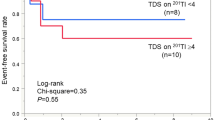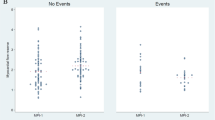Abstract
Objectives: The aim of this study was to assess the prognostic value of the amount of perfusion-metabolic mismatch in revascularized patients with left ventricular (LV) dysfunction by means of Thallium (Tl)-201 and BMIPP imaging.Methods: Seventy-six patients with LV dysfunction and coronary artery disease underwent Tl-201 and BMIPP imaging. They were revascularized with either coronary artery bypass graft or balloon angioplasty and were entered into this study. To quantify the amount of perfusion-metabolic mismatch, SPECT images were displayed as polar maps and analyzed semiquantitatively. The patients were followed up for a mean period of 32 months for cardiac mortality and non-fatal cardiac events. Standard follow-up left ventriculography was performed 6 to 12 months after revascularization.Results: Thirty-two patients exhibited a large amount of perfusion-metabolic mismatch (≥7 segments, group A), 28 patients had a small amount of perfusion-metabolic mismatch (2 to 6 segments, group B), and 16 patients were found to have no perfusion-metabolic mismatch (group C). Similar pre-revascularization LVEF of 35±5%, 34±8% and 36±6% increased to 45±8% (p<0.0001), to 38±8% (p<0.05), and to 36±3% (n.s.), respectively, after revascularization. The functional improvement after revascularization in group A was accompanied by a low rate of cardiac events during follow-up and better cardiac event free survival as judged by the Kaplan-Meier method (p<0.05, vs. group B and C).Conclusion: In revascularized patients with severe LV dysfunction, the presence of a large amount of perfusion-metabolic mismatch evaluated by Tl-201 and BMIPP imaging identifies patients with the best prognosis.
Similar content being viewed by others
References
Kiat H, Berman DS, Maddahi J, et al. Late reversibility of tomographic myocardial thallium-201 defects: an accurate marker of myocardial viability.J Am Coll Cardiol 1989; 12: 1456–1463.
Dilsizian V, Rocco TP, Freedman NM, Leon MB, Bonow RO. Enhanced detection of ischemic but viable myocardium by the reinjection of thallium after stress-redistribution imaging.N Engl J Med 1990; 323: 141–146.
Ragosta M, Beller GA, Watson DD, Kaul S, Gimple LW, Quantitative planar rest-redistribution Tl-201 imaging in the detection of myocardial viability and prediction of improvement in left ventricular function after coronary by pass surgery in patients with severely depressed left ventricular function.Circulation 1993; 87: 1630–1641.
Charney R, Schwinger ME, Chun J, et al. Dobutamine echocardiography and rest-redistribution thallium-201 scintigraphy predicts recovery of hibernating myocardium after coronary revascularization.Am Heart J 1994; 128: 864–869.
Pace L, Perrone-Filardi P, Mainenti PP, et al. Effects of myocardial revascularization on regional thallium-201 uptake and systolic function in regions with reverse redistribution on tomographic thallium-201 at rest patients with chronic coronary artery disease.J Nucl Cardiol 1998; 5: 153–160.
Knapp FF Jr, Franken PR, Kropp J. Cardiac SPECT with iodine-123-labeled fatty acids: evaluation of myocardial viability with BMIPP.J Nucl Med 1995; 36: 1022–1030.
Nohara R, Otsuka K, Ogino M, et al. Evaluation of myocardial viability with iodine-123-BMIPP in a canine model.J Nucl Med 1996; 37: 1403–1407.
Tamaki N, Tadamura E, Kawamoto M, et al. Decreased uptake of iodinated branched fatty acid analog indicates metabolic alterations in ischemic myocardium.J Nucl Med 1995; 36: 1974–1980.
Fukuzawa S, Inagaki M, Morooka S, Inoue T, Sugioka J, Ozawa S. An effective tool to detect lesions causing unstable angina with multivessel disease: iodine-123 beta-methyl-p-iodophenyl pentadecanoic acid single photon emission computed tomography.J Cardiol 1996; 28: 191–198.
Dilsizian V, Perrone-Filardi P, Arrighi JA, et al. Concordance and disconcordance between stress-redistribution-reinjection and rest-redistribution thallium imaging for assessing viable myocardium: comparison with metabolic activity by positron emission tomography.Circulation 1993; 88: 941–952.
Tamaki N, Tadamura E, Kudoh T, et al. Prognostic value of iodine-123 labelled BMIPP fatty acid analogue imaging in patients with myocardial infarction.Eur J Nucl Med 1996; 23: 272–279.
Taki J, Nakajima K, Matsunari I, et al. Assessment of improvement of myocardial fatty acid uptake and function after revascularization using iodine-123-BMIPP.J Nucl Med 1998; 39: 1492–1499.
Hammbye AS, Dobbeleir AA, Vervaet AM, Van den Heuvel PA, Franken PR. BMIPP imaging to improve the value of sestamibi scintigraphy for predicting functional outcome in severe chronic ischemic left ventricular dysfunction.J Nucl Med 1999; 40: 1468–1476.
Fujibayashi Y, Yonekura Y, Takemura Y, et al. Myocardial accumulation of iodinated beta-methyl branched fatty acid analog, iodine-125-15-(p-iodophenyl)-3-(R,S) methyl-pentadecanoic acid (BMIPP), in relation to ATP concentration.J Nucl Med 1990; 31: 1818–1822.
Nishimura T, Uehara T, Strauss HW, et al. Radionuclide assessment of stunned myocardium by alterations in perfusion, metabolic and wall motion.Jpn Circ J 1991; 55: 913–918.
Tamaki N, Kawamoto M, Yonekura Y, et al. Regional metabolic abnormality in relation to perfusion and wall motion in patients with myocardial infarction: assessment with emission tomography using an iodinated branched fatty acid analog.J Nucl Med 1992; 33: 649–657.
Matsunari I, Sago M, Taki J, et al. Kinetics of iodine-123-BMIPP in patients with prior myocardial infarction: assessment with dynamic rest and stress images compared with stress thallium-201 SPECT.J Nucl Med 1994; 35: 1758–1765.
Kawamoto M, Tamaki N, Yonekura Y, Tadamura E, Fujibayashi Y, Magata Y, et al. Combined study with I-123 fatty acid and thallium-201 to assess ischemic myocardium: comparison with thallium redistribution and glucose metabolism.Ann Nucl Med 1994; 8: 47–54.
Lee KS, Marwick TH, Cook SA, et al. Prognosis of patients with left ventricular dysfunction, with and without viable myocardium after myocardial infarction. Relative efficacy of medical therapy and revascularization.Circulation 1994; 90: 2687–2694.
Williams MJ, Odabashian J, Lauer MS, Thomas JD, Marwick TH. Prognostic value of dobutamine echocardiography in patients with left ventricular dysfunction.J Am Coll Cardiol 1996; 27: 132–139.
Eitzman D, Al-Aouar Z, Kanter HL, et al. Clinical outcome of patients with advanced coronary artery disease after viability studies with positron emission tomography.J Am Coll Cardiol 1992; 20: 559–565.
Di Carli MF, Davidson M, Little R, et al. Value of metabolic imaging with positron emission tomography for evaluating prognosis in patients with coronary artery disease and left ventricular dysfunction.Am J Cardiol 1994; 73: 527–533.
Gioia G, Powers J, Heo J, Iskandrian AS, Russell J, Cassel D. Prognostic value of rest-redistribution tomographic thallium-201 imaging in ischemic cardiomyopathy.Am J Cardiol 1995; 75: 759–762.
Marinho NVS, Keogh BE, Costa DC, Lammerstma AA, Ell PJ, Camici PG. Pathophysiology of chronic left ventricular dysfunction. New insights from the measurement of absolute myocardial blood flow and glucose utilization.Circulation 1996; 93: 737–744.
Vanoverschelde J-LJ, Wijns W, Depre C, et al. Mechanisms of chronic regional postischemic dysfunction in humans: new insights from the study of noninfarcted collateral-dependent myocardium.Circulation 1993; 87: 1513–1523.
Author information
Authors and Affiliations
Corresponding author
Rights and permissions
About this article
Cite this article
Furuzawa, S., Ozawa, S., Shimada, K. et al. Prognostic values of perfusion-metabolic mismatch in Tl-201 and BMIPP scintigraphic imaging in patients with chronic coronary artery disease and left ventricular dysfunction undergoing revascularization. Ann Nucl Med 16, 109–115 (2002). https://doi.org/10.1007/BF02993713
Received:
Accepted:
Issue Date:
DOI: https://doi.org/10.1007/BF02993713




